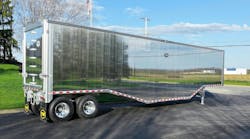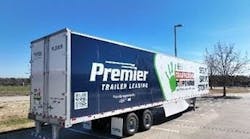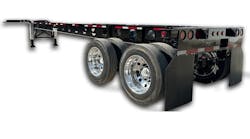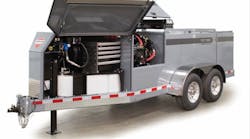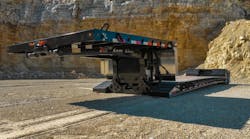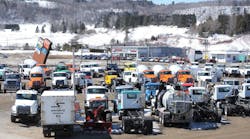CTEA has launched the Job File Level of Excellence, a way of rating companies.
According to CTEA director of technical programs Eddy Tschirhart, Job File is similar to the National Truck Equipment Association's MVP program, except that in Job File, the CTEA physically visits a plant and evaluates how that company is doing business.
“It's a tool with which to rate a member to a status of assurance that they can be considered a supplier of competence — one that meets quality standards and regulations at all levels. Why should I bother doing this? To put yourself out there as someone who is capable. It is a program that would set a CTEA member participating in the process as a ‘Most Valued Supplier’ to their existing and future customers for products and services provided.”
He said that it will take time to build the Most Valued Supplier Program (MVSP), and it is hoped that ultimately clients looking for unknown services to them will be able to get a feeling of confidence with suppliers that are found in the MVSP.
For the trial run, Simard Suspensions Inc came forth as a volunteer company to check out the process.
Tschirhart gave his audience some things to think about when evaluating their companies' operation. Among them:
-
Does the place make you feel welcome? Or is it a yard that is messy and junked up? Is there ample parking for customers? Confidence in your company starts even before the customer gets inside your front door.
-
What do you see when you walk in the front door? Is the area clean? Is there a reception area with a staffed work station?
-
How well does your phone system work? Can customers easily reach the person they are calling? What happens if the customer leaves a message? Is the voice mailbox full? If you want customers to be able to talk to you, you'd better be open for business.
-
What does the customer see when he walks into the shop? Is it clean and organized? Does your shop give the impression of being organized and efficient?
-
Parts and warehouse. Are parts organized and easily located? What about outside storage? When customers see clean, well-organized operations, it reinforces the idea that the company knows what it is doing.
-
Care of vehicles. For those in the truck equipment business, how carefully do you take care of the customer's vehicles?
-
Is there a quality control process in place? Does the system reflect the needs of the customer, or is it merely for the convenience of the company? Can you track the work done on each vehicle?
“There is quality control from management to sales to engineering to production planning to parts manufacturing to final vehicle completion to customer service,” he said. “Methods of quality control include: a paper trail of parts from individual production through to be used on the completed vehicle; checking templates; use of jigs and fixtures for accuracy.
“Job kits are assembled with parts being identified from batch parts. These parts can be tracked from individual production to the chassis they are used on.”
Compliance is generated from the engineering department.
Test trial
Tschirhart said Simard has spent a lot of money for testing to be sure the company could certify/verify its work to be compliant, especially with CMVSS 121.
Patrice Gaudreault, an engineer with Simard Suspensions, reported on how his company complies with Canadian regulations.
He said Simard is registered with Transport Canada under NSM #E81 as: a final- and intermediate-stage manufacturer for body and equipment, wheelbase alterations, and GA/GVWR increase.
He said there are requirements that must be met by any company that is involved in multi-stage vehicle fabrication.
Documents that a company must have in hand before starting work on any vehicle: vehicle OEM Incomplete Vehicle document (IVD); and any Intermediate Manufacturer Document (IMD) if applicable.
“You need to make sure the compliance labels on the vehicle reflect the information in those documents as well as the chassis components,” he said.
The compliance label must have an NSM picture, registered company name, vehicle axle, tires, rims, and axle rating information as required by TC.
In addition to the general compliance requirements, he said a company must make sure all the bodies installed comply to lighting requirements, and perform weight distribution, payload analysis, and vertical CG calculations.
Record of any additional testing performed in order to validate compliance to any CMVSS standard the equipment installation affects must cover all cases, and worst-case scenarios can cover multiple cases.
If the company is an intermediate-stage manufacturer, it must:
-
State “Incomplete Vehicle/Véhicule Incomplet” on the compliance label.
-
Issue an IMD with a statement on compliance to any CMVSS standards affected and put into the vehicle.
-
Take a copy of the OEM IVD and any intermediate manufacturer IMD and leave originals in the vehicle.
In addition to the general compliance requirements, the company must:
-
Be able to prove compliance to any CMVSS requirement affected by the modification with either an OEM written statement or a test report, such as a brake timing test.
-
Perform weight distribution, payload analysis, and vertical CG calculations. It must cover all cases, and worst-case scenarios can cover multiple cases. In some applications, GVWR can't be the sum of all GAWRs.
-
Provide a record of any additional testing performed in order to validate compliance to any CMVSS standard the wheelbase alteration affects.
If the GVWR increase involves the addition of axle(s), capacity (specs) of all components are added: suspension; axle; tires; wheels; and steering components.
Intermediate-stage manufacturer must: state “Incomplete Vehicle/Véhicule Incomplet” on compliance label; issue an IMD with listed final GAWRs and GVWR as well as statement on compliance to any CMVSS standards affected and put into vehicle; and take a copy of the OEM IVD and any intermediate manufacturer IMD and leave originals in the vehicle.
How to establish GAWR:
-
GAWR of any axle is determined by the “weakest link” (rating) among suspension; axle; wheels; tires (be careful to use proper single or dual rating); and steering components (linkages and hydraulic power) if it's a steer axle.
-
GVWR of a vehicle is the lowest of: the sum of all GAWRs; frame capacity (through a “Donor chassis” letter from the OEM); the GVWR at which the CG height is at the limit set by the chassis OEM (IVD); and park brake capacity. (It can be challenging when the added axle doesn't have parking brakes.)
“Liability and cost for compliance increases with GVWR, so give the customer just what he needs,” he said. “With EPA '07 and EPA '11, exhaust modifications affect compliance. We worked with truck and engine OEMs to insure compliance.
“Job File Level of Excellence brought us a lot. We had some holes in our compliance process that this process pointed out. Our liability is now better covered. At the end of the day, it only took some time on the management level to do it, and the cost of producing a compliant unit is not significantly higher than producing a non compliant one. Compliance of a vehicle produced in multistage is a ‘damned if you do, damned if you don't’ thing. You will always be accountable for the work you perform on a chassis, even if you decide not to comply with NSM. Compliance to NSM greatly reduces liability risks and keeps everybody's liability where it belongs.”
Find more coverage of the CTEA's 48th annual Manufacturer's Conference here: January 2012 issue
